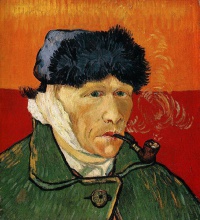Self-Portrait with Bandaged Ear and Pipe, the purest version of the two ‘bandaged’ portraits.
Vincent van Gogh‘s two Self—Portraits with Bandaged Ear are the most perfect visual expression of the concept of the tortured artist, an artist who in this particular case literally in an act of self-torture cut off his own ear.
Van Gogh was a beautiful loser unacknowledged during his lifetime and posthumously rewarded with success.
One other painting in the category ‘existential angst’ comes to mind, the far more famous The Scream, depicting an artist tortured by existential angst.


Apropos of your question elsewhere about the reason for the name Malbrough Theme: although Bakhtin doesn’t mention the source of the term anywhere, I presume that Malbrough is a reference to the song “Malbrough s’en va-t-en guerre”, a merry, mocking ditty about the (imaginary) death in battle of the Duke of Marlborough (Malbrough is the French pronunciation, whence the Russian Mal’bruk), in other words an example of the debasing death, the carnivalesque “snizhenie” (bringing low) of the high and mighty, another example of which is the death of Claudius in the Apocolocyntosis. The tune of “Malbrough s’en va-t-en guerre” itself seems to be a cultural signifier for mocking deflation – rather like the musical equivalent of a whoopee cushion or blowing a raspberry. The best literary example of this comes during Chichikov’s visit to Nozdryov in Gogol’s Dead Souls: Nozdryov’s hurdy-gurdy (sharmanka), which seems to have a mind of its own, unexpectedly interrupts the tune it is playing and breaks into an impertinent rendition of “Malbrough s’en va-t-en guerre”.
Might Wolfgang Kayser mention the “Malbrough Theme” in “Die Grotesk in Malerei und Dichtung” (a book I haven’t read)? It is in his discussion of Kayser that Bakhtin first uses the term.
Thanks you for your eclaration.
I have Kayser’s book in the univesity library. I will check it.
Love your blog
Yours
Jan Willem
At the KMSKA library today, I consulted Kayser’s The Grotesque in Art and Literature, I checked for references of the Malbrough theme, but did not find any.
Yours
Jan Willem
I’ve finally managed to solve the question of the origin of Bakhtin’s use of “the Malbrough Theme”, thanks to an article in the Toronto Slavic Quarterly (http://www.utoronto.ca/tsq/30/goldenberg30.shtml), on the subject of the tunes played by Nozdyov’s hurdy-gurdy in Dead Souls, which include “Malbrough s’en va-t-en guerre”. A Russian translation of the French song was published in an almanack in 1792, but such was the popularity of the tune that the carnivalesque popular imagination – the voice of the lower corporeal bodily stratum, as it were – inevitably created its own rude version of the original words. (Cf. in this respect http://en.wikipedia.org/wiki/Hitler_Has_Only_Got_One_Ball) In the Russian scatological version of the song, quoted in the aforementioned article, Marlborough eats sour cabbage soup and shits himself to death:
Мальбрук в поход собрался
Наелся кислых щей…
Он к вечеру обклался
И умер в тот же день.
Четыре генерала
Портки его несли,
И тридцать три капрала
Г…о из них трясли.
(Malbrough left for the war / He ate sour cabbage soup… / That evening he paid the toll / And died the very same day. / Four generals / It took to carry his trousers / And thirty-three corporals / To get the shit out of them.) (N.B. “Г…о” is the polite way of rendering “govno” (shit) in print.)
Therefore, Bakhtin must be alluding to this familiar (to Russians) example of death during the act of defection found in oral folk culture.
lower bodily material stratum, I meant to say
Great,
I will soon add it to my encyclopedia.
Greetings!
With pleasure. Do get in touch at my e-mail address.
All the best!